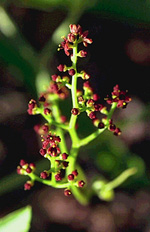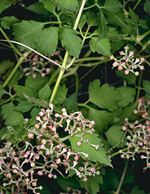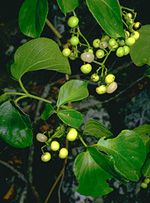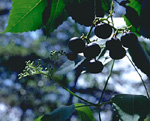 |
This medium-sized family is mainly tropical and subtropical with minor extension into temperate latitudes. In Australia most species occur in tropical woodlands, and tropical and subtropical rainforests generally at low elevation, from the Kimberley region of Western Australia around the north coast and thence south as far as eastern Victoria.
Characteristic features of the family Vitaceae in Australia include:
- woody climber with alternate, usually palmately divided leaves and
leaf-opposed tendrils
- flowers small, usually yellowish, borne in small panicles in the axils
of, or opposite, the leaves
- sepals 4–5, fused into a cap that falls off as the flower opens;
petals separate or falling like the sepals
- stamens the same number as the petals and adjacent to them
- ovary superior and often immersed in a fleshy disc, developing into
a fleshy berry
Description
Evergreen, deciduous or semi-deciduous, woody or perennial
herbaceous vines climbing by tendrils. Tendrils opposite leaves, or apparently
terminating inflorescence axes. Vegetative reproduction absent, or by
tubers. Stem nodes conspicuously swollen or not; internodes terete, oval,
slightly or strongly flattened, or distinctly angular. Internal secretions
not obvious. Plants glabrous, or with simple or dendritic, non-glandular,
unicellular or uniseriate hairs. Leaves alternate and spiral, cauline
if herbs, petiolate. Stipules absent or present, distinct and free from
the petiole, scale-like, membranous, or green and leafy, falling off early;
stipellae absent. Lamina simple, once compound or bicompound, ternate,
palmate, imparipinnate, symmetric, pinnatifid or pinnatisect; lamina/leaflets
filiform, acicular, subulate, linear, lanceolate, ovate, elliptic, oblong
or orbicular; base cuneate, attenuate, rounded, cordate, hastate, sagittate
or oblique; margins entire, crenate, dentate, serrate, ±flat; venation
pinnate, or palmate, with the midrib conspicuous, and the tertiary venation
reticulate or not; surfaces not punctate; herbaceous or leathery. Domatia
absent or consisting of pits or pockets in the vein angles. All the flowers
bisexual, or rarely with bisexual and male flowers occurring on some plants
and bisexual and female flowers on others. Inflorescences terminal, axillary
or leaf opposed, consisting of panicles, corymbs, umbels or dichasial
cymes. Bracts present. Pollination by insects. Flowers odourless, stalked.
Floral disc present; nectaries present on the disc. Perianth regular,
of 2 dissimilar whorls, valvate in bud. Calyptra present or absent. Calyx
segments fused, with 4–5 lobes; calyx salver-shaped, herbaceous. Corolla
segments free, of 4–5 petals, alternating with the calyx lobes, white,
cream, yellow or green, rarely red, without contrasting markings, succulent;
claws absent; lobes ±entire. Fertile stamens 4 or 5, alternating
with the calyx lobes, free of the corolla, free of the ovary and style,
distinct from each other, all ±equal. Staminodes present or absent.
Anthers dorsifixed, versatile, opening inwards by longitudinal slits,
2-celled. Ovary superior and sessile. Carpels 2, fused; ovary with 2 locules.
Style terminal, single and unbranched and the stigma truncate, capitate
or lobed. Ovules 2 per locule, stalked; placentation basal. Fruit a fleshy,
indehiscent berry; the perianth on the maturing fruit deciduous or dry
and persistent. Disseminule micro-surface ±smooth, iridescent,
white, cream, magenta, purple, violet, brown or black, glossy or dull.
Seeds 1–4 per fruit. Aril absent. Cotyledons 2. Embryo straight.
(Note: this description has been generated from the coded data compiled for the key. Any errors in the key data will be reflected in the descriptions.)
A treatment of the family Vitaceae has not yet been published in the Flora of Australia. It will appear in Volume 24.
Australian genera of Vitaceae (as recognised for the Flora of Australia)
* = all species introduced
Ampelocissus
Cayratia
Cissus
Clematicissus
*Parthenocissus
Tetrastigma

|
  |

Ampelocissus acetosa (flowers)
Photo: M.Fagg © M.Fagg

Cayratia clematidea (flowers)
Photo: M.Fagg © M.Fagg

Cayratia saponaria (fruits)
Photo: G.Leiper © G.Leiper

Cayratia trifolia (flowers and fruit)
Photo: J.Wrigley © ANBG

|
 |
|